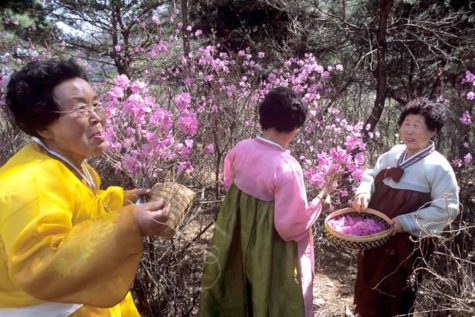Daily Archives: April 9, 2016
Samjinnal is a Korean holiday that falls on March 3 of the lunar calendar. Three being a positive number in numerology, this date containing two threes was considered to be highly auspicious. This festive day announces the arrival of spring. By this time, spring is usually in full bloom – the weather is warm, the young grass is a lively green, and the first flowers are blooming.
Note: Because this holiday is based on the lunar calendar, on Gregorian Calendars the date will vary from year to year. In 2016, this holiday was celebrated on April 9th, in 2017, this holiday falls on March 30.
It is known as the day the swallows came back from Gangnam and the day the snake came out from its winter sleep. It is also the day birds and butterflies start to appear.
Koreans believed that swallows left for their southward journey on ninth day of the ninth lunar month and returned back on Samjinnal. They started to repair their old nests under the eaves or built the new ones to hatch their young.
Many seasonal activities associated with spring took place on this day. Villagers headed out on a blossom tour of the nearby mountains as the gardens were increasingly frequented by butterflies, fresh-green buds became visible on tree branches and the hills and prairies put on their colorful spring dresses.
Popular picnic foods included flower petal pancakes and other seasonal delights. Banquets were also held around this time of year to treat senior members of the community to special meals. For the noblemen across the country, Samjinnal was a day of archery contests.
Flower petal pancakes for the blossom picnic were made with glutinous rice batter, formed in circles, fried in a pan with sesame oil and topped with azalea petals. A special dessert known as hwamyeon was prepared by putting slices of mung-bean dough cakes into omija (favor flavor berries)-scented water, and flavoring it with honey and pine nuts. When preparing the mung bean dough for this dessert, housewives sometimes added azalea petals to it. If they made the dough with honey and dyed it red, the dish would be called sumyeon.
Sumyeon was considered a ritualistic dish as it was frequently used for memorial services.One of the beliefs associated with Samjinnal is that seeing a white butterfly on that day was an ominous sign since white signifies mourning. The sighting of a white butterfly could result in a family member dying during the course of the year.
Tiger or yellow butterflies on the other hand were considered an excellent sign, and portended a lucky year. Women made sure they washed their hair on Samjinnal as they believed it would make their hair vigorous and beautiful throughout the year. Snakes that came out of their hibernation around that time were avoided at all costs since seeing these slithering creatures was regarded as unlucky.
Other names for this holiday:
It was called samjil (삼질) in oldKorean language and referred to as sangsa (상사, 上巳), wonsa (원사, 元巳), sungsam(중삼, 重三), sangje (상제, 上除) or dapcheongjeol (답청절, 踏靑節) in hanja. Samjinnal implies the overlapping of Sam (three). According to Choi Namseon, samjil was derived from the consonants of Samil, and Sangsa is defined as the first snake day of the 3rd lunar month.
Source: Wikipedia and Encyclopedia of Korean Folk Culture




